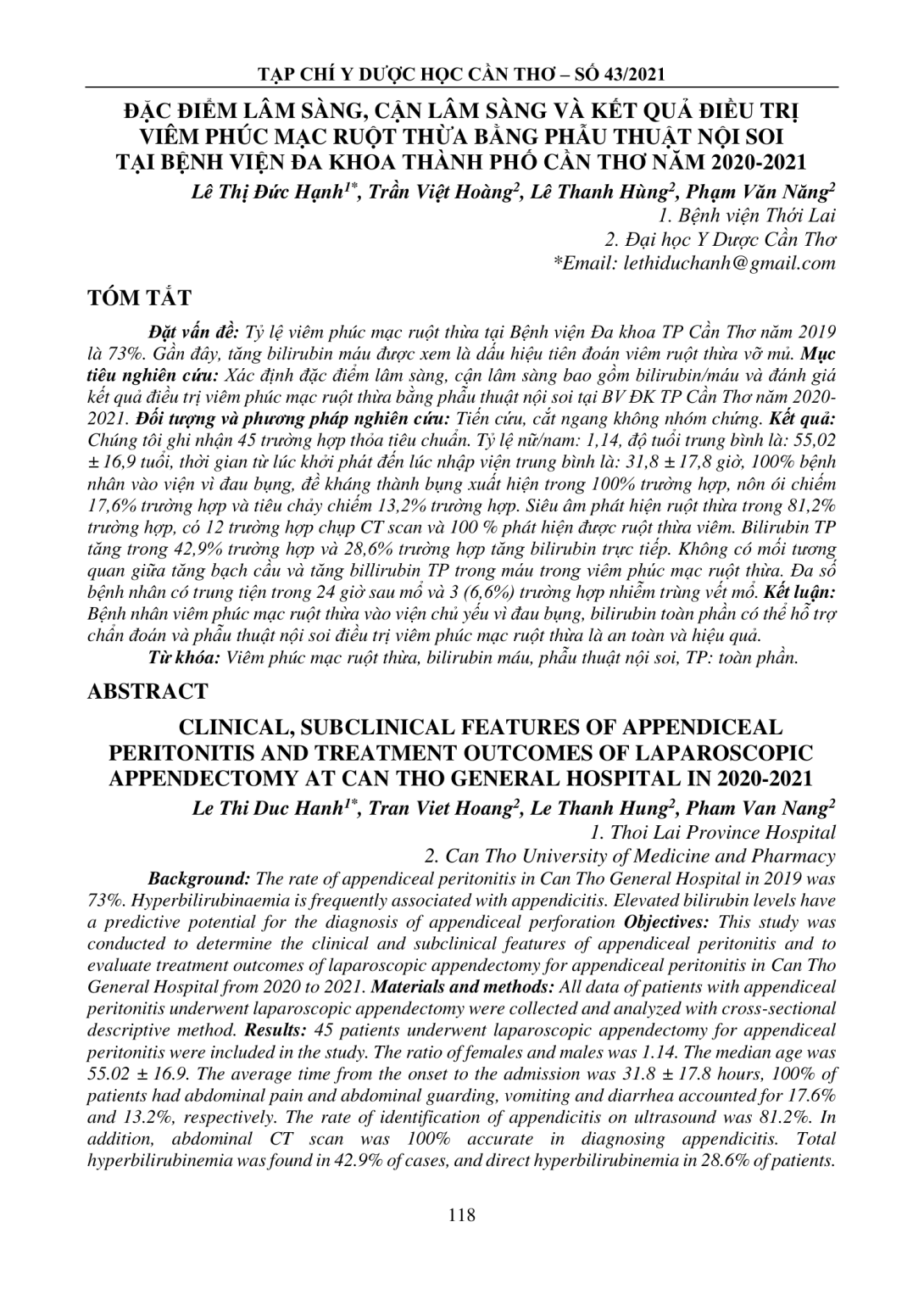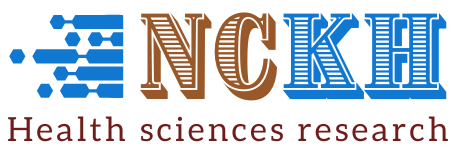
Tỷ lệ viêm phúc mạc ruột thừa tại Bệnh viện Đa khoa TP Cần Thơ năm 2019 là 73%. Gần đây, tăng bilirubin máu được xem là dấu hiệu tiên đoán viêm ruột thừa vỡ mủ. Mục tiêu nghiên cứu: Xác định đặc điểm lâm sàng, cận lâm sàng bao gồm bilirubin/máu và đánh giá kết quả điều trị viêm phúc mạc ruột thừa bằng phẫu thuật nội soi tại BV ĐK TP Cần Thơ năm 2020- 2021. Đối tượng và phương pháp nghiên cứu: Tiến cứu, cắt ngang không nhóm chứng. Kết quả: Chúng tôi ghi nhận 45 trường hợp thỏa tiêu chuẩn. Tỷ lệ nữ/nam: 1,14, độ tuổi trung bình là: 55,02 ± 16,9 tuổi, thời gian từ lúc khởi phát đến lúc nhập viện trung bình là: 31,8 ± 17,8 giờ, 100% bệnh nhân vào viện vì đau bụng, đề kháng thành bụng xuất hiện trong 100% trường hợp, nôn ói chiếm 17,6% trường hợp và tiêu chảy chiếm 13,2% trường hợp. Siêu âm phát hiện ruột thừa trong 81,2% trường hợp, có 12 trường hợp chụp CT scan và 100 % phát hiện được ruột thừa viêm. Bilirubin TP tăng trong 42,9% trường hợp và 28,6% trường hợp tăng bilirubin trực tiếp. Không có mối tương quan giữa tăng bạch cầu và tăng billirubin TP trong máu trong viêm phúc mạc ruột thừa. Đa số bệnh nhân có trung tiện trong 24 giờ sau mổ và 3 (6,6%) trường hợp nhiễm trùng vết mổ. Kết luận: Bệnh nhân viêm phúc mạc ruột thừa vào viện chủ yếu vì đau bụng, bilirubin toàn phần có thể hỗ trợ chẩn đoán và phẫu thuật nội soi điều trị viêm phúc mạc ruột thừa là an toàn và hiệu quả
The rate of appendiceal peritonitis in Can Tho General Hospital in 2019 was 73%. Hyperbilirubinaemia is frequently associated with appendicitis. Elevated bilirubin levels have a predictive potential for the diagnosis of appendiceal perforation Objectives: This study was conducted to determine the clinical and subclinical features of appendiceal peritonitis and to evaluate treatment outcomes of laparoscopic appendectomy for appendiceal peritonitis in Can Tho General Hospital from 2020 to 2021. Materials and methods: All data of patients with appendiceal peritonitis underwent laparoscopic appendectomy were collected and analyzed with cross-sectional descriptive method. Results: 45 patients underwent laparoscopic appendectomy for appendiceal peritonitis were included in the study. The ratio of females and males was 1.14. The median age was 55.02 ± 16.9. The average time from the onset to the admission was 31.8 ± 17.8 hours, 100% of patients had abdominal pain and abdominal guarding, vomiting and diarrhea accounted for 17.6% and 13.2%, respectively. The rate of identification of appendicitis on ultrasound was 81.2%. In addition, abdominal CT scan was 100% accurate in diagnosing appendicitis. Total hyperbilirubinemia was found in 42.9% of cases, and direct hyperbilirubinemia in 28.6% of patients. The rate of appendiceal peritonitis in Can Tho General Hospital in 2019 was 73%. Hyperbilirubinaemia is frequently associated with appendicitis. Elevated bilirubin levels have a predictive potential for the diagnosis of appendiceal perforation Objectives: This study was conducted to determine the clinical and subclinical features of appendiceal peritonitis and to evaluate treatment outcomes of laparoscopic appendectomy for appendiceal peritonitis in Can Tho General Hospital from 2020 to 2021. Materials and methods: All data of patients with appendiceal peritonitis underwent laparoscopic appendectomy were collected and analyzed with cross-sectional descriptive method. Results: 45 patients underwent laparoscopic appendectomy for appendiceal peritonitis were included in the study. The ratio of females and males was 1.14. The median age was 55.02 ± 16.9. The average time from the onset to the admission was 31.8 ± 17.8 hours, 100% of patients had abdominal pain and abdominal guarding, vomiting and diarrhea accounted for 17.6% and 13.2%, respectively. The rate of identification of appendicitis on ultrasound was 81.2%. In addition, abdominal CT scan was 100% accurate in diagnosing appendicitis. Total hyperbilirubinemia was found in 42.9% of cases, and direct hyperbilirubinemia in 28.6% of patients.
- Đăng nhập để gửi ý kiến
